Introduction
In the Aesthetics of Design class here at CU Boulder, our first project is to design something with a specific aesthetic using only upcycled materials such as cardboard, scrap wood, scrap plastic, etc. When I first started this project, I wanted to make something small (something I could carry) and also something I would use after the fact (something functional). I brainstormed a few ideas such as a koozie made out of wine corks, a pencil holder using broom bristles, or a wine rack made from old soup cans. However, none of them really grabbed my attention so I decided to pursue this spoon lamp device. I found the idea from a DIY website[1] and thought it was visually appealing and that the supplies could be gathered quite easily. Looking through the internet, there are a few different styles of the lamp and it can be customized and altered in a few different ways such as how the spoons are overlaid and the color of the spoons, bottles, and LED. This project was rewarding as well as difficult. In the end, I am happy with the way it turned out.
Vision
I decided to make a lamp small enough for a desk but bright enough to give off enough light to be functional. I have found desk lamps that either emphasize the functionality or the aesthetic of the design. For me, the lamps that are extremely functional (i.e. can bend in different ways, clip on to things, give off sufficient light) are not always aesthetic, and that the aesthetic lamps are not always functional. Although my spoon lamp cannot bend and clip on to surfaces, it does give off sufficient light and has an awesome look. I was going for a natural aesthetic as well as something like a Dale Chihuly piece you would see in a botanical garden pictured below in Figures 1 and 2.
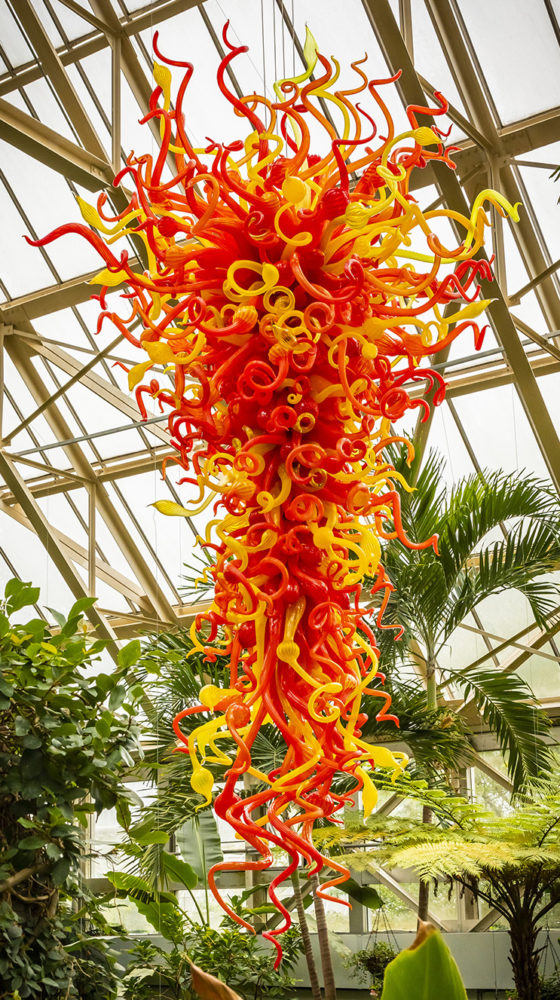
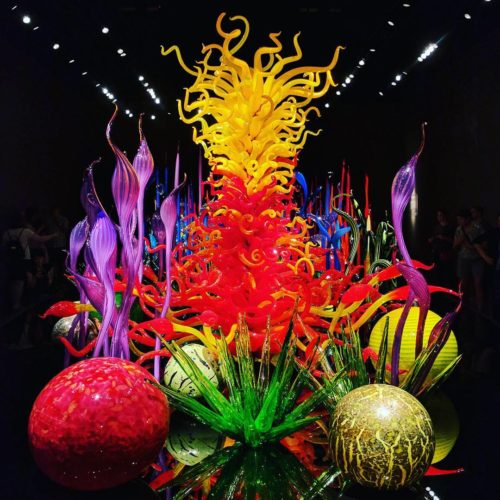
Chihuly typically works in primary colors, although he has expanded outside of those, and uses all sorts of shapes including cylinders, baskets, and all types of swoopy and curved forms. His art would best be categorized as contemporary and has had a tremendous influence on the glass blowing art form. I have always been fascinated by the skill required to bend and color and form the glass in the way Chihuly does. I recently visited a botanical gardens in Columbus, OH that was featuring some of his work including the chandelier in Figure 1. I remember looking up at this piece, which is about 15 feet in length, and being completely mesmerized by the colors and the way the glass snakes around itself; it’s almost as if it is alive. So, I decided to try to apply this aesthetic to my lamp.
Design Process
Ideally, my typical design process is to first define a problem and list out its requirements. With the need statement of the problem, I then start brainstorming and generating various ideas and concepts for the solution, and once there are a couple ideas worth pursuing, I pretotype them and evaluate their feasibility. Moving forward with one design concept, I further prototype it, iterating and improving it along the way with validation from testing. From there, I determine the most optimal manufacturing and assembly processes to use. Through out the design process, I am in a constant feedback loop with the client and design specifications to ensure I make design decisions with the input from the end user along the way.
In this project, I did not follow the ideal design process. When designing for aesthetics, the end goal is emotional–to make the audience or user feel something. With this project, there were not strict engineering specifications and analytical solutions, and the need statement was rather abstract: make something that has this specific aesthetic. I did generate a variety of concepts and ideas initially, but it was much harder to narrow in on one idea. Instead of having a client from whom I could receive feedback and deliver the product to, I was checking to make sure the design met my “loose” aesthetic requirements. I found it difficult to not have those boundaries and numbers I typically have when designing something in regards to engineering. I did not iterate on the final design as much, however, I did iterate my assembly and manufacturing processes along the way. I changed small things like how to best glue the spoon onto the piece, and if the glue should go on the piece or on the spoon, before adhering them together. Below are a few preliminary sketches I made to get an idea of what it may look like.
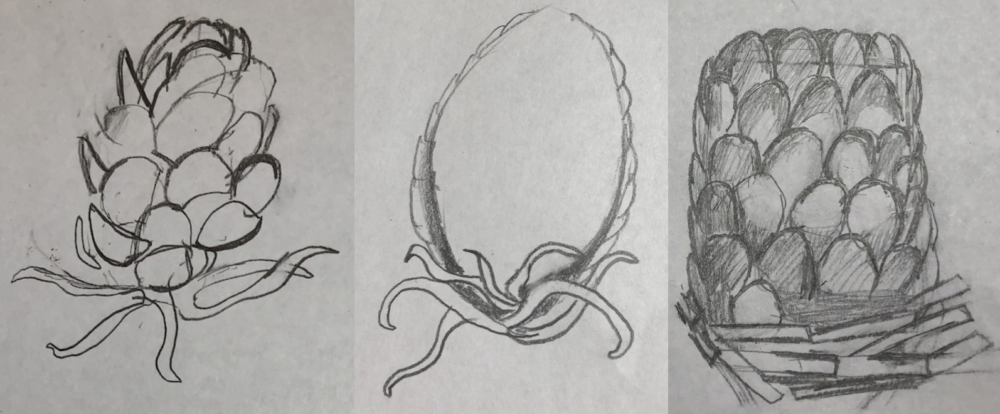
When it came time to build the second lamp, I found my process to be a lot more linear. Refer to Figure 3 and 4 for a comparison of my ideal design process and the one I used on this project. In general, these more artistic projects–where the end goal is more abstract than just a value or test result–seem to have a more linear path where the direction is completely determined by that first step, whether you decide a medium first or an aesthetic first. Once you start going down one path, it can quickly lead to a dead end or a disappointing failure.


Fabrication Process
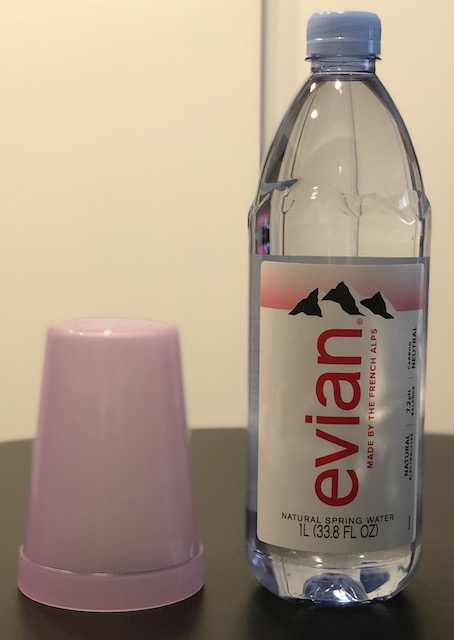
My first step in the fabrication process was to gather all my materials and tools. I built two lamps: one taller using a clear plastic water bottle and a shorter one using a red plastic cup. Because I could not find ~100 identical spoons, I ended up buying some. I wanted uniformity among the spoons to give the lamp a cleaner look. Throughout the project I used a hot glue gun, scissors, and wire cutters. I first cut the spout and bottom of the water bottle off with the scissors. I then cut the stems of the spoons off using the wire cutters, varying the length of stem left on the spoon depending on where it was to be mounted. I started at the top of the water bottle (by the spout) and started gluing the spoons around the circumference making sure they were equally spaced. I then repeatedly overlaid the spoons at the next level down and kept moving down and around, filling in gaps when necessary.
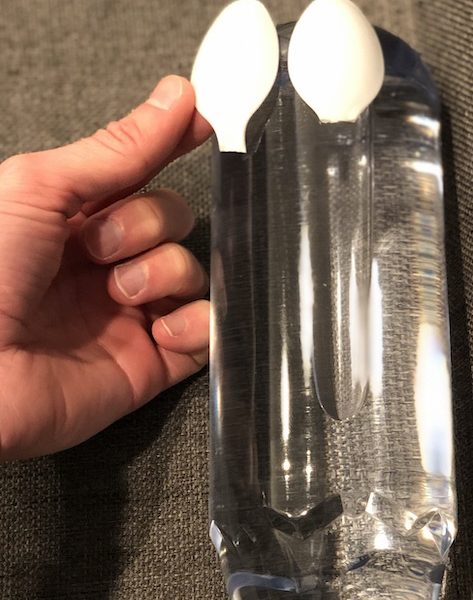
The first lamp took quite some time and many more spoons than I anticipated. I started out putting glue on the bottle and trying to stick the spoon to the glue, but found a better way to hold the spoon while I applied the glue to the edges. My process was this: one spoon at a time, determine where exactly it was to go, determine the mating surfaces, apply the glue to the spoon at those surfaces, and adhere it to the piece. As a finishing touch, I used the stems of the spoons and glued them in a spiraling pattern on the stem of the water bottle. I laid them tangent on the water bottle and glued them down. I then needed something to rest the lamp ports on, so I glued together some Bass wood to create a stand. The wood gives them a more earthy feel similar to the feel of the Chihuly pieces in the botanical gardens. Refer to Figures 8 and 9 for the final product. I, unfortunately, did not record my fabrication process, however, here is a video I used to help guide me through; it shows a step-by-step tutorial [4]. The process is pretty simple, but it is tedious. Once the hot glue is on the plastic, it is extremely hard to remove. It was difficult to keep the glue from smudging or dripping on the outside of the spoon to preserve the clean finish, and I had to restart a few times before getting a hang of it.
Final Product
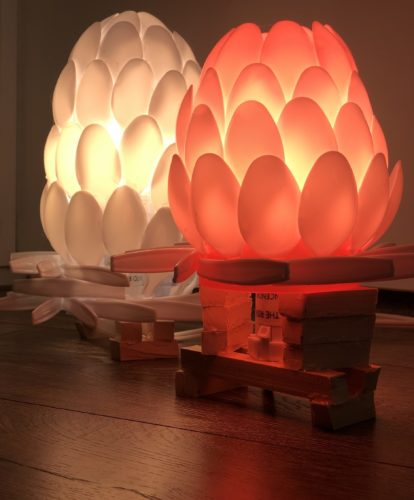
The final product can be seen in Figures 8 and 9. The spoons are overlaid similarly to fish scales or the feathers of a bird in how scales are evenly distributed and perfectly covering every space between the scales under it. In these lamps, I purposely left small cracks and holes between the spoons to allow enough light to come through, but the same idea is there. Each spoon is supported by the ones below it, providing a natural structure. The stems of the spoons are there to cover up the bottom layer of spoons, but also give the lamp a “spiked” look and more depth while also attempting to mimic the Chihuly pieces in Figures 1 and 2.
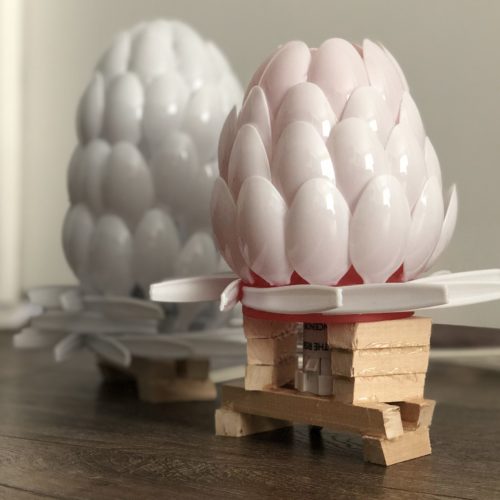
Analysis and Future Iterations
As far as my functional goals, I am happy with the amount of light they give off. The hot glue also stuck pretty well to the plastics so the lamps are decently durable. In terms of my artistic goals, I am happy the way it turned out. It was a long and tedious process and there are a few minor blemishes, but it works great. The lamps are definitely different looking and grab your attention. As far as a lamp goes, I think it does a decent job of mimicking Chihuly’s pieces which are often in primary colors and absolutely mesmerizing shapes and texturess. All in all, I am happy with the overall outcome.
I plan to recreate and refine this lamp shade. I noticed that as I was working on the second lamp, the process became much more efficient and I was able to smooth out some of the hiccups I experienced while doing the first one. Although, it was still difficult to prevent the hot glue from dripping and smudging all over the outside of the spoons. I would iterate and try to find other ways the spoons can be overlaid (horizontally, at bigger angles, etc.) and other ways to incorporate the stems of the spoons. I was limited with the tools I had available at the time when I was designing and making the stands, but I would iterate further on those and polish them up. I would also investigate other colors of spoons, plastics, and light. It would also be interesting to use an RGB LED that could be controlled remotely to change the color of the light. To take it a step further, the “spoons” could be 3D printed, etching contours and textures into the back side of the “spoon”; the texture and contours would then be pronounced when the light shines through. At this stage, I plan to keep the lamp until I have time to make another one.
Video Presentation
Click the following link to see a video of the presentation I gave to my group of classmates:
References
[1] “Spoon Lamp.” Instructables. Accessed February 10, 2020. https://www.instructables.com/id/Spoon-Lamp/.[2] “Installations | Chihuly.” Accessed February 10, 2020. https://www.chihuly.com/work/installations.
[3] Tes Teach with Blendspace. “Chihuly – Lessons – Tes Teach.” Accessed February 10, 2020. https://www.tes.com/lessons/EGU8QikZORf_eQ/chihuly. [4] DIY Plastic Spoon Lamp | Easy Step By Step. Accessed February 10, 2020. https://www.youtube.com/watch?v=YcB7CIHVKP4.
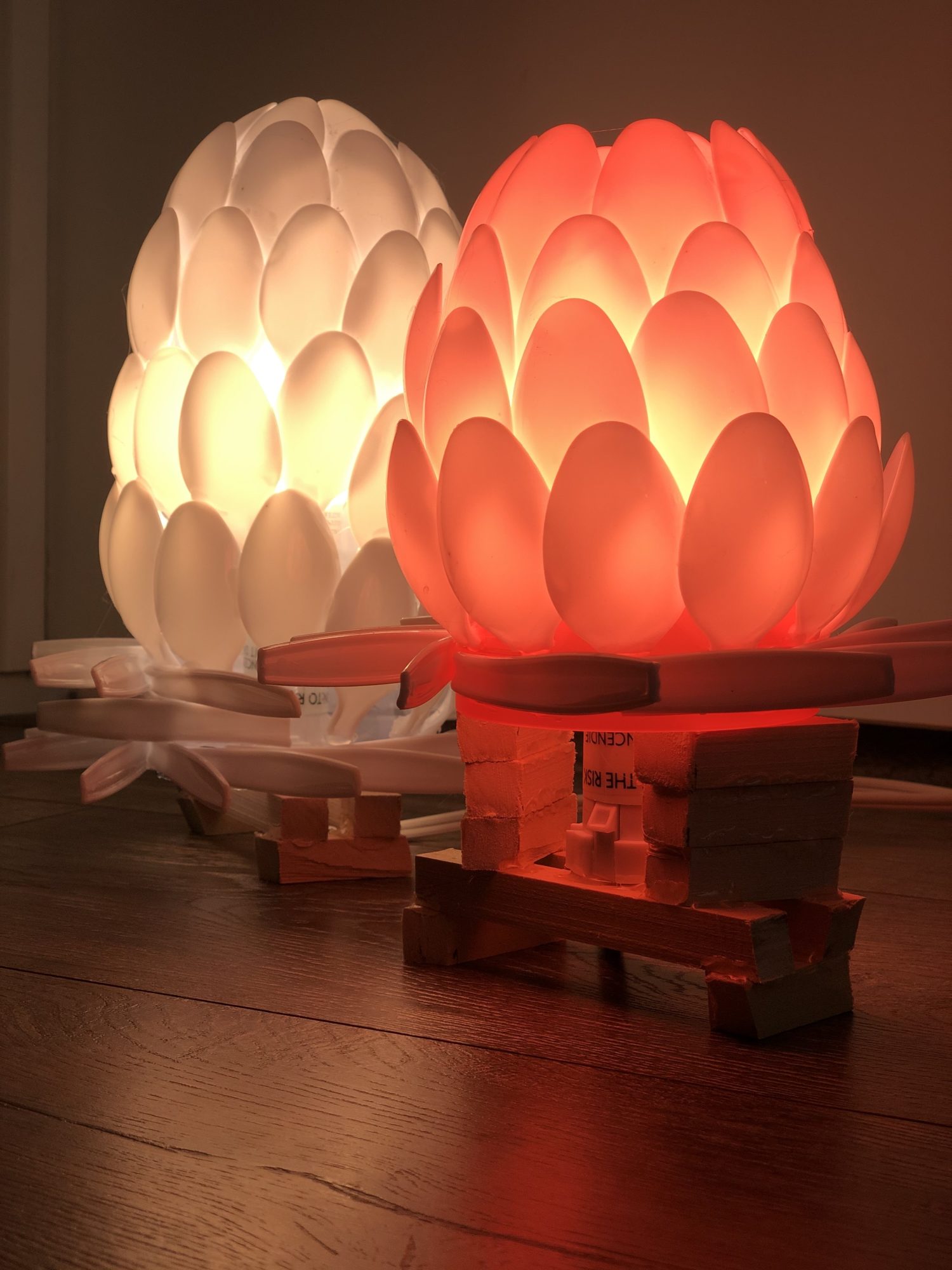
4 Comments. Leave new
I think you have a really interesting project. I like the final product and how it turned out to be, and I am pretty sure you worked hard to make it. I think the idea that inspired you about Chihuly is really interesting and artistic, and no wonder you had a well organized design process. One of the things that caught my attention was the curved spoon grips above the wood blocks. How did you manage to bend them without breaking them? Is addition how are the spoons placed as a whole piece? Can you just take the whole thing up or is it glued to the wood beneath? One last question, are you planning on improving the base of the lamp? do you have an idea already?
If I may suggest something, have you thought about mixing different spoon colors instead of one? Also, it might look really cool if you add some paint that glows in the dark to some features like at the base or in a certain pattern. Overall, I like the project and think you did a really good job!
Hi Abdulrahman, thanks for you comment. To answer your question about the spoon stems, they are actually not bent or curved, but are just laying tangent on the base of the bottle and cup. As far as the spoons go, I started at the top of the bottle/cup, and slowly worked my way down, overlaying the spoons on the row above it. The lamp shades are not mounted to the wooden stand, and can lift off the stand. I was thinking about redesigning the stand so they latch onto the lamp shade in some sort of way. And yes, I thought about using different color spoons. I think using dark spoons could look really cool, and that was my initial idea, but I couldn’t find enough dark colored spoons. Thanks for your input.
Hi Daniel, really great work pulling off the spoon lighting fixture, I was curious how you achieved the angles of the curved part of the spoons? You mentioned it being hard to get them to stay in place given the small surface area of the perimeter, did you just end up holding them in place by hand while applying the glue? Or did you discover another method? I liked the touch of the spiral of stems at the bottom, I thought it truly came to resemble something of the Chihuly aesthetic as it gave it a sort of whimsical, “exploding” feel a lot of his work has.
Hi Thomas. Thanks for your comment. So I initially tried to hold the spoons in place and then apply the glue, but it was hard to hide and disguise the glue that way, and I found the glue would just smudge on the outside of the spoon. So, I started to apply the glue to the spoon itself, and then place the spoon. This ended up working out a lot better, but took some iteration on the process. As far as getting the angles, it really depends on the length of the stem left over on the spoon. The nub of the stem gave more surface area that could be used to glue the spoon down, but the spoon could also be pivoted around that part of the stem, giving the desired angle. Thank you.